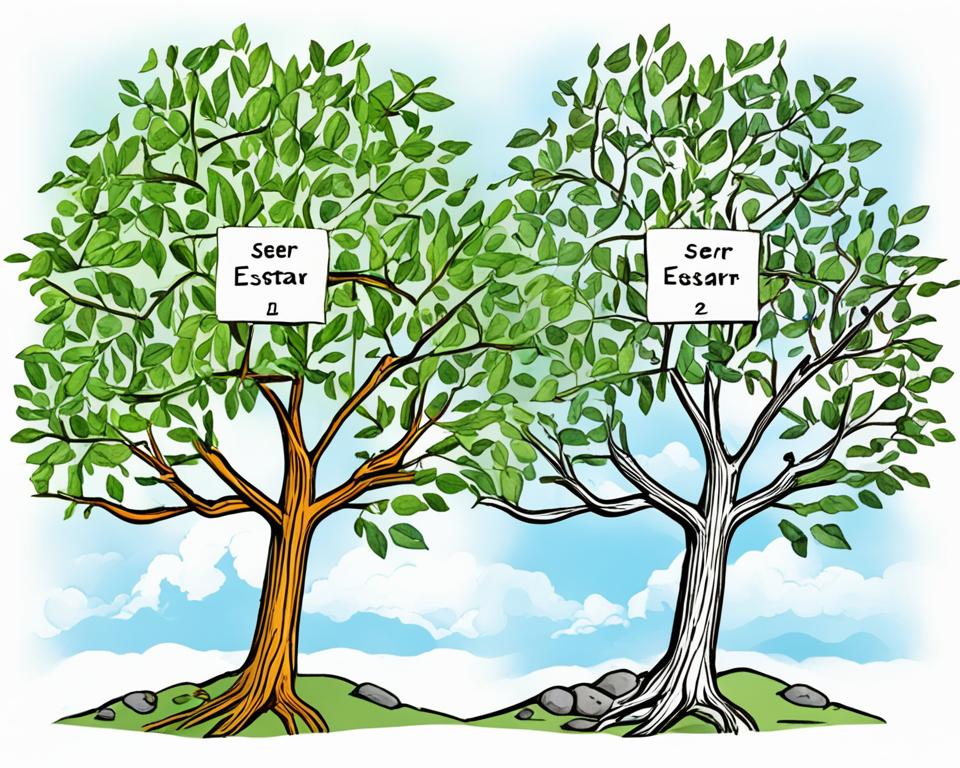When it comes to learning Spanish, mastering the correct usage of the verbs ser and estar is essential. These two verbs play a crucial role in expressing identity, describing conditions, and conveying various states in the Spanish language.
In this article, we will explore in detail the different uses and applications of ser and estar, and how understanding their nuances can greatly enhance your language skills. Whether you are a beginner or looking to refine your Spanish proficiency, this comprehensive guide will provide you with the knowledge and practice exercises to confidently use ser and estar in the correct contexts.
So, let’s embark on this journey to unravel the intricacies of ser and estar and unlock the key to fluency in Spanish.
Key Takeaways:
- Understanding the differences between ser and estar is crucial for accurate communication in Spanish.
- Ser is used to express identity, characteristics, and permanent attributes.
- Estar is used to describe temporary conditions, locations, and emotions.
- Choosing the appropriate verb depends on the specific context and the meaning you want to convey.
- Mastering the conjugation of ser and estar in different tenses is essential for effective communication.
Introduction to Ser and Estar
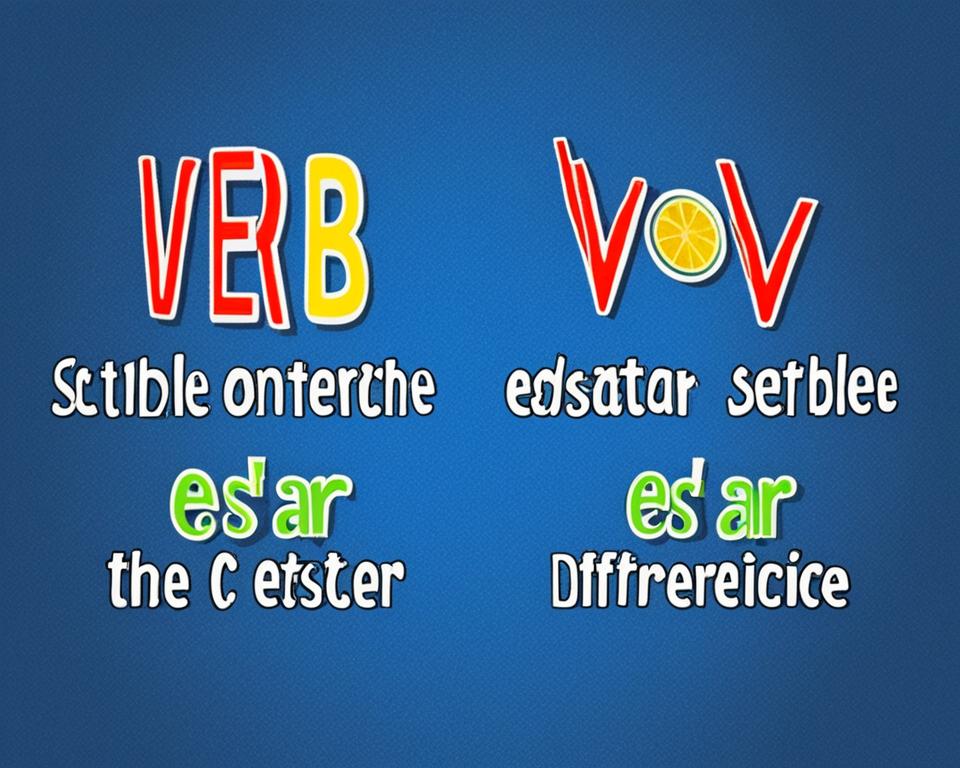
Understanding the fundamental differences between ser and estar is essential when learning Spanish. These two verbs may seem similar at first, but their usage varies significantly depending on the context. By grasping the nuances between ser and estar, you can communicate more accurately and precisely in the Spanish language.
“Ser” and “estar” are Spanish verbs that both translate to “to be” in English. However, they are not interchangeable and serve distinct purposes. To use them correctly, it’s essential to understand their specific uses and the contexts in which each verb is appropriate.
Let’s explore the main differences between ser and estar in the table below:
| Ser | Estar |
|---|---|
| Used for permanent characteristics | Used for temporary states |
| Describes inherent characteristics | Describes conditions or states at a specific moment |
| Expresses identity and nationality | Expresses location and current conditions |
| Used for telling time | Used for expressing emotions |
As you can see, ser is generally used for permanent traits or characteristics, while estar is used for temporary conditions or states. However, there are some exceptions and subtleties that we will explore in further sections of this article.
Now that you have a brief introduction to the differences between ser and estar, let’s delve deeper and explore each verb’s specific uses in Spanish.
Ser – Expressing Identity and Characteristics

When it comes to expressing personal identity, physical traits, and inherent characteristics in Spanish, the verb ser plays a crucial role. Understanding its various uses will not only enable you to communicate more effectively but also provide you with a deeper appreciation of the language. Let’s explore how ser can be utilized to convey essential features of people, objects, and places.
Expressing Personal Identity
One of the primary uses of ser is to express personal identity. Whether stating your name, nationality, profession, or other defining attributes, ser helps establish who you are. For example:
Yo soy Ana García. – I am Ana García.
Ella es ingeniera. – She is an engineer.
Describing Physical Traits
Ser is also employed to describe physical traits of individuals or objects. These characteristics are considered inherent and permanent. Take a look at the following examples:
Él es alto y moreno. – He is tall and dark-skinned.
La casa es grande y blanca. – The house is big and white.
Portraying Inherent Characteristics
Additionally, ser is used to portray inherent characteristics, such as personality traits or inherent qualities of places. Here are a few examples:
Mi amiga es inteligente y amable. – My friend is intelligent and kind.
Barcelona es hermosa y vibrante. – Barcelona is beautiful and vibrant.
Understanding the appropriate use of ser in expressing identity and characteristics is essential for accurate communication in Spanish. Below is a summary table highlighting the different uses of ser discussed:
| Use | Example |
|---|---|
| Expressing personal identity | Yo soy Ana García. |
| Describing physical traits | Él es alto y moreno. |
| Portraying inherent characteristics | Mi amiga es inteligente y amable. |
Mastering the use of ser will enable you to express personal identity and convey essential features more accurately. Now that we have explored ser’s role in expressing identity and characteristics, let’s move on to the next section to discover the uses of estar in describing conditions and states.
Estar – Describing Conditions and States
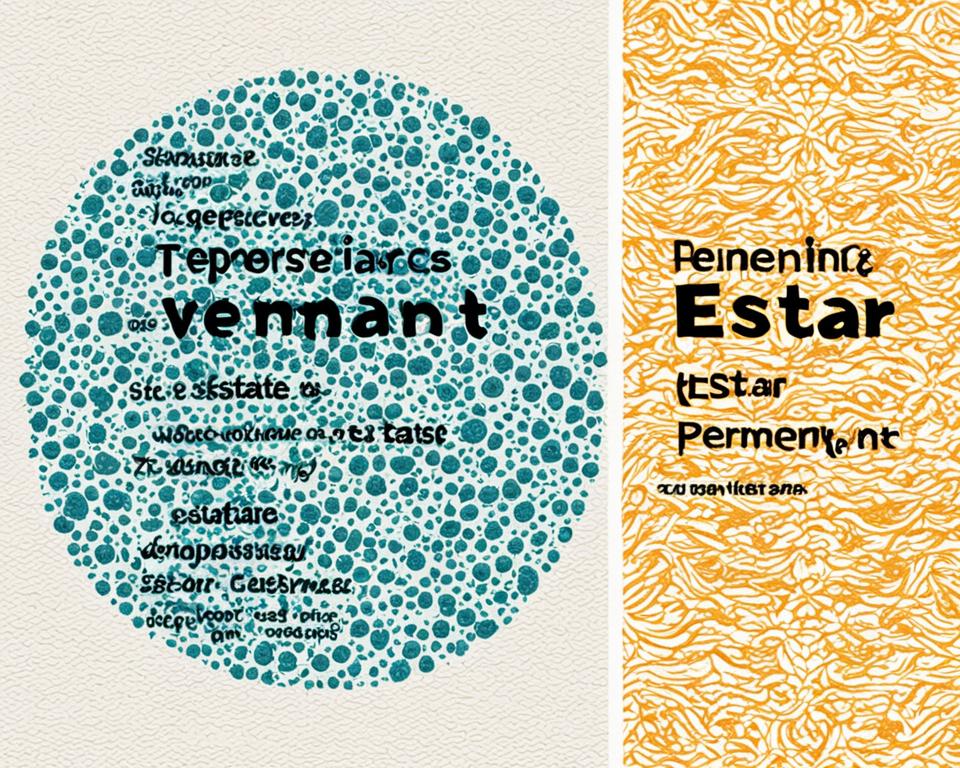
In Spanish, the verb estar plays a crucial role in describing various conditions and states. Unlike the verb ser, which expresses permanent characteristics and identities, estar is used to convey temporary conditions, locations, emotions, and states of being.
When discussing physical or emotional states, estar is the go-to verb. It allows us to express how someone feels or the current condition of something. Whether it’s describing someone’s mood, the weather, or the state of an object, estar provides the necessary linguistic tools.
“Todo en la vida es temporal. Si las cosas van bien, disfrútalas, porque no durarán para siempre. Y si las cosas van mal, no te preocupes. No pueden durar mucho tiempo, tampoco.” – Brian Tracy
In the following table, you’ll find some common uses of estar:
| Use of Estar | Example |
|---|---|
| Describing physical location | Estoy en casa. (I am at home.) |
| Expressing current emotions | Estoy feliz. (I am happy.) |
| Describing temporary conditions | Él está cansado. (He is tired.) |
| Indicating states of being | Las flores están marchitas. (The flowers are withered.) |
By understanding and correctly using estar, you’ll be able to paint a vivid picture of temporary conditions and states in your Spanish conversations. However, it’s important to note that mastering the distinction between ser and estar is essential for effective communication.
Ser vs. Estar – Essential Vocabulary and Adjectives
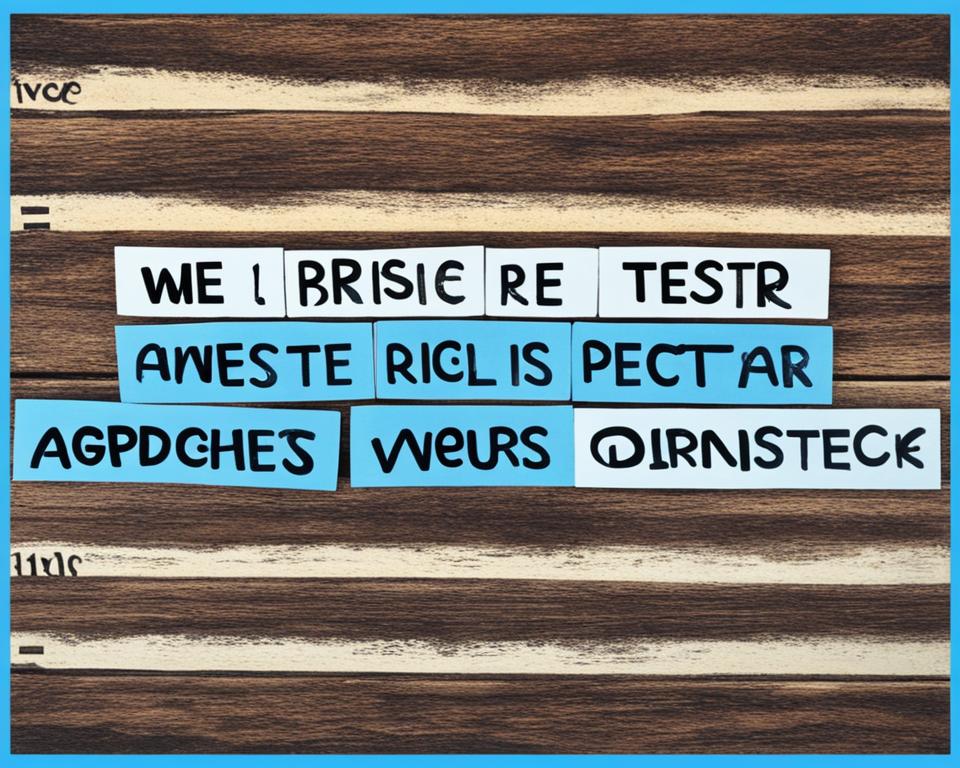
When using the Spanish verbs ser and estar, it is crucial to consider the essential vocabulary and adjectives associated with each. By understanding the appropriate usage of these verbs in different contexts, you can accurately convey the intended meaning in your communication. Let’s explore some common vocabulary and adjectives that are typically used with ser and estar, helping you make the right linguistic choices.
1. Ser is often used to express permanent or intrinsic characteristics, such as:
- Nationality: soy español/a (I am Spanish)
- Profession: eres médico/a (You are a doctor)
- Physical attributes: es alto/a (He/She is tall)
2. Estar is used to describe temporary states or conditions, including:
- Location: estoy en casa (I am at home)
- Emotions: está feliz (He/She is happy)
- Health: estamos enfermos (We are sick)
It is important to note that some adjectives can change the meaning depending on whether you use ser or estar. For example:
- Ser aburrido: to be boring (intrinsic characteristic)
- Estar aburrido: to be bored (temporary state)
Remember, the key to choosing the appropriate verb is to analyze the intended meaning and consider the duration or permanence of the described state or characteristic. With practice, you will develop a strong intuition for when to use ser or estar correctly.
“Language is the road map of a culture. It tells you where its people come from and where they are going.” – Rita Mae Brown
With this knowledge of essential vocabulary and adjectives, you can now navigate the distinction between ser and estar with confidence. Understanding how to choose the appropriate verb based on the meaning you want to convey is a valuable language skill that will greatly enhance your Spanish fluency.
Ser and Estar in the Present Tense
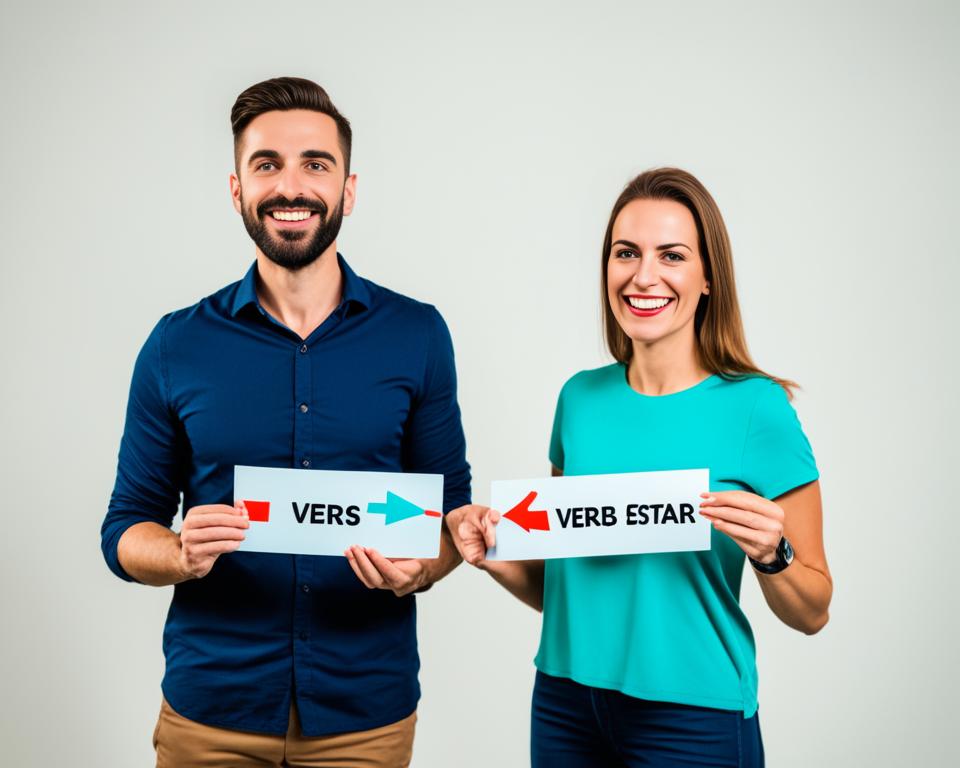
To effectively communicate in Spanish, it is essential to master the conjugation of the verbs ser and estar in the present tense. Understanding how to use these verbs accurately in different situations will significantly enhance your language skills. Here’s a breakdown of their conjugation:
| Ser (To Be) | Estar (To Be) |
|---|---|
| Yo soy | Yo estoy |
| Tú eres | Tú estás |
| Él/Ella/Usted es | Él/Ella/Usted está |
| Nosotros/Nosotras somos | Nosotros/Nosotras estamos |
| Vosotros/Vosotras sois | Vosotros/Vosotras estáis |
| Ellos/Ellas/Ustedes son | Ellos/Ellas/Ustedes están |
Remember, ser is used to express inherent qualities, identity, and characteristics that are not likely to change. Estar, on the other hand, is used to describe temporary states, conditions, and locations. Let’s dive deeper into their usage:
Using Ser in the Present Tense
Ser is commonly used to express personal identity, physical traits, nationality, professions, and permanent qualities. Here are a few examples:
- Tú eres una persona amable. (You are a kind person.)
- Ella es médica. (She is a doctor.)
- Nosotros somos estadounidenses. (We are Americans.)
Using Estar in the Present Tense
Estar is used to describe temporary conditions, locations, emotions, and states of being. Take a look at these examples:
- Estamos en la playa. (We are at the beach.)
- Él está nervioso. (He is nervous.)
- Las manzanas están maduras. (The apples are ripe.)
“Knowing when to use ser and estar correctly in the present tense will allow you to convey information accurately and effectively.”
Mastering the conjugation and usage of ser and estar in the present tense is a fundamental step towards fluency in Spanish. In the next section, we will explore how these verbs are used in the past tense.
Ser and Estar in the Past Tense

Conjugating verbs in the past tense is essential for expressing actions or conditions that occurred in the past. Let’s explore how to conjugate the verbs ser and estar in the past tense and understand their nuanced usage.
Conjugation of Ser in the Past Tense
When using ser to talk about past events or states, we need to conjugate it differently depending on the subject. Here is the conjugation of ser in the past tense:
| Subject Pronoun | Conjugation of Ser |
|---|---|
| Yo | fui |
| Tú | fuiste |
| Él/Ella/Usted | fue |
| Nosotros/Nosotras | fuimos |
| Vosotros/Vosotras | fuisteis |
| Ellos/Ellas/Ustedes | fueron |
Conjugation of Estar in the Past Tense
In the past tense, estar is used to describe temporary conditions or locations that have changed. Here is the conjugation of estar in the past tense:
| Subject Pronoun | Conjugation of Estar |
|---|---|
| Yo | estuve |
| Tú | estuviste |
| Él/Ella/Usted | estuvo |
| Nosotros/Nosotras | estuvimos |
| Vosotros/Vosotras | estuvisteis |
| Ellos/Ellas/Ustedes | estuvieron |
Remember to match the verb form with the subject pronoun to convey the correct meaning in the past tense.
By mastering the conjugation of ser and estar in the past tense, you’ll be able to accurately express past actions and conditions in Spanish.
Ser and Estar in the Future Tense

As you continue your journey of mastering the Spanish verbs ser and estar, it’s essential to explore their usage in the future tense. By understanding how to conjugate ser and estar accurately in the future tense, you can effectively express upcoming actions and states.
Similar to other tenses, ser and estar have specific conjugation patterns for the future tense. Let’s take a look at how these verbs transform:
| Ser in the Future Tense | Estar in the Future Tense |
|---|---|
| Yo seré | Yo estaré |
| Tú serás | Tú estarás |
| Él/Ella/Usted será | Él/Ella/Usted estará |
| Nosotros/Nosotras seremos | Nosotros/Nosotras estaremos |
| Vosotros/Vosotras seréis | Vosotros/Vosotras estaréis |
| Ellos/Ellas/Ustedes serán | Ellos/Ellas/Ustedes estarán |
The future tense of ser is used to indicate actions or states that will occur in the future and are considered more permanent. For example:
Mañana seré profesor de español.
Tomorrow I will be a Spanish teacher.
On the other hand, estar in the future tense is used to express temporary conditions or states that will happen in the future. Here’s an example:
Estaremos en la playa la próxima semana.
We will be at the beach next week.
Remember, as with other tenses, context plays a significant role in choosing between ser and estar in the future tense. Pay attention to the nature of the action or state you want to convey in order to select the appropriate verb.
In the next section, we’ll explore additional uses of ser and estar, including advanced applications that will further enhance your understanding of these versatile verbs.
Additional Uses of Ser and Estar

Once you have a good understanding of the basic uses of ser and estar, you can delve into their advanced applications. These versatile verbs offer additional ways to express various concepts and ideas in Spanish. Let’s explore some of the advanced uses of ser and estar:
Expressing Possession
Ser is commonly used to express possession, indicating ownership or relationship. For example:
La casa es de Juan.
The house belongs to Juan.
Estar, on the other hand, is used to indicate temporary possession or location. For example:
El libro está en la mesa.
The book is on the table.
Forming Passive Voice
Ser is also used to form the passive voice in Spanish, emphasizing the action or state rather than the doer. Here’s an example:
El regalo es dado por Pedro.
The gift is given by Pedro.
Indicating Changes
Estar is often used to express temporary changes or states of being. It can convey transitions, emotions, and conditions that are not considered permanent. For instance:
Marta está feliz hoy.
Marta is happy today.
As you continue to explore the Spanish language, remember to pay attention to the context and meaning when using ser and estar in advanced applications. Practice using these verbs in various scenarios to further develop your language skills.
Practice Exercises for Ser and Estar
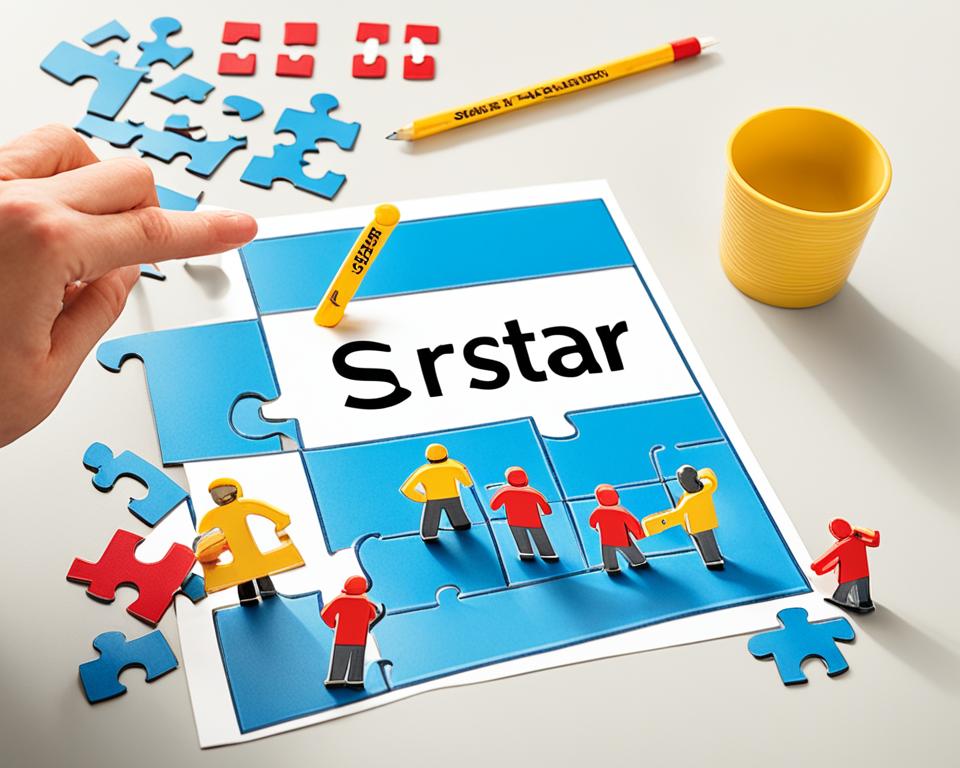
Now that you have learned the various uses and differences between ser and estar, it’s time to put your knowledge to the test with some practice exercises. These interactive exercises will help you reinforce your understanding and improve your ability to use ser and estar correctly in different contexts. Through practice, you will gain confidence in selecting the appropriate verb and expressing yourself accurately in Spanish.
Before moving on to the exercises, let’s review some key points:
- Ser is used to express identity, characteristics, professions, nationalities, and permanent attributes.
- Estar is used to describe temporary conditions, emotions, locations, and states of being.
- Consider the meaning you want to convey and the context in which the sentence or phrase is used to determine whether to use ser or estar.
Now, let’s dive into the practice exercises:
Sentence Completion Exercise
Complete the following sentences by choosing the correct form of ser or estar:
- Mi hermana ______ médica. (Fil in the blank with either ser or estar)
- La fiesta ______ en el parque. (Fill in the blank with either ser or estar)
- Yo ______ muy cansado hoy. (Fill in the blank with either ser or estar)
- El libro ______ interesante. (Fill in the blank with either ser or estar)
Vocabulary Match Exercise
Match the following vocabulary words with the correct verb, ser or estar:
| Vocabulary Word | Correct Verb |
|---|---|
| Aburrido/a | ______ |
| Estudiante | ______ |
| Enfermo/a | ______ |
| Alto/a | ______ |
Short Answer Questions
Answer the following questions using the appropriate form of ser or estar:
- ¿Cómo ______ tú? (Fill in the blank with either ser or estar)
- ¿Dónde ______ Carlos? (Fill in the blank with either ser or estar)
- ¿Qué hora ______? (Fill in the blank with either ser or estar)
- ¿Por qué ______ triste? (Fill in the blank with either ser or estar)
Take your time and think through each exercise carefully. Once you’ve completed the exercises, you can check your answers to see how well you’ve understood ser and estar.
Remember, practice is the key to mastering these verbs and improving your language skills. Keep practicing and soon you’ll feel confident in your ability to use ser and estar accurately.
Conclusion
In conclusion, mastering the correct usage of the Spanish verbs ser and estar is essential for enhancing your language skills. Throughout this article, we have explored the various uses and applications of ser and estar, understanding their differences and when to use them appropriately in different contexts.
By using ser, we can express personal identity, physical traits, and inherent characteristics of people, objects, and places. On the other hand, estar allows us to describe temporary conditions, locations, emotions, and states of being.
Furthermore, we have discussed the essential vocabulary and adjectives that go hand in hand with ser and estar, enabling us to choose the appropriate verb based on the meaning we want to convey. We have also covered the conjugation of ser and estar in the present, past, and future tenses, as well as their advanced uses.
By reviewing and practicing the uses of ser and estar, you can solidify your understanding and confidently apply these verbs in your Spanish conversations. So, keep practicing and exploring the nuances of ser and estar to further enhance your language skills!
FAQ
What are the main differences between ser and estar?
Ser and estar are both Spanish verbs that are used to express different aspects of being or existence. Ser is used to talk about permanent characteristics, identities, professions, nationalities, and origin. Estar, on the other hand, is used to describe temporary states, locations, emotions, and conditions.
How do I know when to use ser or estar?
Choosing between ser and estar can sometimes be challenging. As a general rule, use ser when talking about essential, inherent qualities or characteristics, and use estar when describing temporary states or conditions. However, there are exceptions and idiomatic expressions to consider, so it’s important to study and practice to become more familiar with their usage.
Can you give me some examples of when to use ser?
Certainly! Some examples of when to use ser would be: “Soy de España” (I am from Spain), “Soy alto” (I am tall), and “Ella es médico” (She is a doctor).
When should I use estar instead of ser?
Estar is used to describe temporary conditions or states, such as “Estoy cansado” (I am tired), “Estoy en casa” (I am at home), and “Está feliz” (He/she is happy).
Are there any adjectives that are typically used with ser or estar?
Yes, there are certain adjectives that are commonly used with ser or estar. For example, ser is typically used with adjectives such as “inteligente” (intelligent), “alto” (tall), and “rubio” (blonde), which describe inherent traits. Estar, on the other hand, is used with adjectives such as “cansado” (tired), “feliz” (happy), and “enfermo” (sick), which describe temporary states or conditions.
How do I conjugate ser and estar in the present tense?
In the present tense, the conjugations of ser are: “soy” (I am), “eres” (you are), “es” (he/she/it is), “somos” (we are), “sois” (you all are), and “son” (they are). For estar, the present tense conjugations are: “estoy” (I am), “estás” (you are), “está” (he/she/it is), “estamos” (we are), “estáis” (you all are), and “están” (they are).
Can ser and estar also be used in the past tense?
Yes, both ser and estar can be conjugated in the past tense. For example, the past tense conjugations of ser are: “fui” (I was), “fuiste” (you were), “fue” (he/she/it was), “fuimos” (we were), “fuisteis” (you all were), and “fueron” (they were). The past tense conjugations of estar are: “estuve” (I was), “estuviste” (you were), “estuvo” (he/she/it was), “estuvimos” (we were), “estuvisteis” (you all were), and “estuvieron” (they were).
How do ser and estar work in the future tense?
In the future tense, ser is conjugated as follows: “seré” (I will be), “serás” (you will be), “será” (he/she/it will be), “seremos” (we will be), “seréis” (you all will be), and “serán” (they will be). Estar, in the future tense, is conjugated as: “estaré” (I will be), “estarás” (you will be), “estará” (he/she/it will be), “estaremos” (we will be), “estaréis” (you all will be), and “estarán” (they will be).
Are there any other uses of ser and estar?
Yes, apart from their main uses, ser and estar have additional applications. For example, ser is used to express possession (“Es mi libro” – It’s my book), form the passive voice (“El libro fue escrito” – The book was written), and indicate changes (“Está hecho de metal” – It’s made of metal). Estar, on the other hand, is used to express progressive actions (“Está corriendo” – He/she is running) and to indicate a state that is the result of a change (“Está roto” – It’s broken).
How can I practice using ser and estar?
There are various practice exercises available to help you improve your understanding and usage of ser and estar. You can find online quizzes, worksheets, and interactive exercises that allow you to practice choosing the correct verb in different contexts. Additionally, it’s helpful to engage in conversation or writing activities where you can apply ser and estar in real-life situations.

